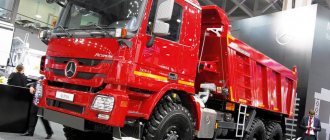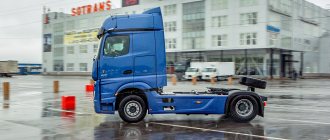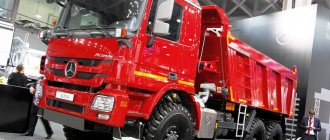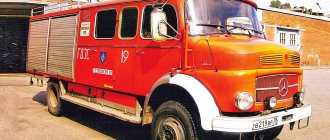Send request
| Wheel formula: | 6×4 |
| Type: | chassis |
| Engine: | 265 kW / 360 hp |
| Cabin: | M-cabin |
| Price: | 204 000 € |
| Make, body model | Zoeller XXL for MSW and KGM |
| Body volume, body type | 24 m3, stiffeners |
| Pressing ratio | Up to 1:6 |
| Gross vehicle weight | 33,000 kg |
| Wheel formula | 6x4 |
| Engine power | 265 kW / 360 hp |
| Engine/Transmission Warranty | 3 years / 250,000 km |
| Gear shift | Automatic PowerShift 2 |
| Cabin type | M, 2 passenger seats |
| Lifting device | Zoeller SK200+ portal Welaki |
| Receiving bath thickness | 10mm |
| Body control | Automatic and semi-automatic |
| Type of containers served | MGB 120 - 1100 l., Russian-made containers 0.8 m3, boat-type bunkers with a volume of 7-8 m3. |
Additional equipment
- Tap for draining liquid from the receiving hopper;
- Valve for draining fluid from the front of the body;
- Rear view camera including monitor
- Mount for broom and shovel;
- Seal between tailgate and packer;
- Hatch for equipment maintenance;
- Tail lights, brake lights and turn signals;
- Reversing light - 1 pc.;
- Fog rear light – 1 pc.;
- Work area lighting lamp – 2 pcs;
- Side marker lights;
- Flashing beacon – 2 pcs.
- Central body lubrication system
And again everything is about him
Are you looking forward to more stories about shiny pipes and original handrails around the roof? It’s in vain, there won’t be any, they are not included in the package of our MB Actros, so I will talk about more prosaic things.
For example, about the cabin. It's classic, daytime. The entrance to it opens with a slight movement of the hand... It’s somehow boring, so we’ll skip listing the bells and whistles. Among the “chips” worthy of mention are a pair of huge folding visors above the windshield and a sliding curtain on the left door. It looks primitive, but in terms of functionality it outshines many other solutions.
I also liked that the driver and passenger seats can be placed in the same row with the engine tunnel. Of course, the bed is not for sleeping every night, but it’s quite possible to rest for a couple of nights. For those who are more picky or simply employed in jobs with a large shoulder, it is possible to install a cabin with a “sleeping bag” - the space behind the body allows this.
Or this is ETO. The hood opens with latches from the street, giving access to almost all filler necks. With the appropriate skill, you can add them without special devices, but I would still recommend taking a watering can with you - there is less hassle. You can also replace the air or cabin filters without resorting to manipulations in the control room.
Those for whom curiosity is not a vice, but a way of education, after a short warm-up of 69 pumps can still admire the engine with the cockpit raised. Even more likely reclined, since I did the last 10 pumps, really fearing that she would simply slide to the ground under her own weight. An impressive angle, and even with it, nothing fell out of the pockets on the back wall. The reverse process surprised me with its accuracy - the same 69 strokes until the lock clicked. When the cabin is raised, there is convenient access to the headlights and sound signal, of which, by the way, there are two - electric and pneumatic. The button on the instrument panel is responsible for choosing which one will buzz.
Definitely positive emotions were caused by the fact that all axles are “shod” with rubber of the same size and with the same tread pattern, which means that there is one “spare” for everyone, and besides, the wheels are interchangeable. Our construction sites will quickly appreciate this.
All familiar faces
Yes, we will again talk about Meiller products. Another imported dump truck we took for testing turned out to be equipped with the next model of this famous European body builder. That, in fact, is all about the tipper body of our ward.
Just kidding, of course, there are a couple of nuances that I think are worth noting. I will compare with the models featured in our previous tests (IVECO Trakker AD380T 38H and MAN TGA 40.480 6x4 BB-WW). In terms of configuration and equipment, the superstructure is closer to Meiller 7755322/70192032. It loses to this body in only one way - there are no auxiliary steps under the side, and therefore you will have to start climbing up using the side underrun protection. But how long does it take to skillfully - one or two and we are already at board height. True, according to the law of the genre, it turns out that “skillfully, it takes a long time.” The metal strips, welded inside the dumping platform in the form of a ladder and designed to make working with the body easier, are placed too close to the wall, and even in summer shoes the foot tends to slip off. How less flexible drivers will use them, especially in tarpaulin boots, without which they don’t take a step on our construction sites, I don’t know. However, on the above-mentioned model there are no such things, so there is parity.
But the rest seems to be the same, but not quite. The heating of the body by exhaust gases is directed downwards - a “minus”, but the very fact of its presence on a car with an engine that meets Euro 4 standards due to the use of urea is a “plus”. The visor is again too short - the soil will spill onto the gearbox - again a “minus”. But it is covered with a protective cover - “plus”. And the visor itself is removable, so if you doubt the professionalism of the “guy with a big shovel on a caterpillar track,” you can take a larger visor in reserve; I believe you can find one in the Meiller price list.
Overall conclusion: the body is fully consistent with its label and even a little more. And judging by our estimates, this “slightly more” can pull five to ten tons, the dimensions of the body will allow this, and its declared load capacity of 23,000 kg will also partly be the same. But the chassis is not designed for this - at least, we did not find references to such “maximum” use in the operating manual. Therefore, we recommend carefully monitoring the amount of cargo poured so as not to prematurely lose the factory warranty of 36 months or 250 thousand km on the power line.
Speaking of instructions, don’t forget to read them before you start using them. Raising the body on a whim is difficult. The fact is that the power take-off switch is not fixed. You pressed it, the built-in light blinked, and there was no reaction of the body to manipulations with the control lever. And a shamanic dance begins around the control units, with varying degrees of success for us. The three of us with our colleagues performed this action a couple of times, until my partner Slava Valdanov finally read the clever book and said that we simply didn’t have enough patience - we didn’t even have time to really press the selection button, but already the shuru control lever. And Actros doesn’t like fuss; I pressed the button - wait ten seconds. And as soon as a large clear diagram for switching on possible interlocks lights up on the panel, you can start working with the lifting remote control. The book is a source of knowledge, and it’s not for nothing that it has more than 320 pages.
"Mercedes" in traffic jams...
“Did you drive an automatic?” - "Yes". - "Bon Voyage!" – This is what the last parting words looked like when handing over the car. The confidence of the company representatives came at the right time; ahead lay a piece of the Moscow Ring Road and the Dmitrovskaya highway in the midst of a working day.
Setting up the mirrors and adjusting the seat and steering column takes about five minutes. The final act of this ritual, of course, is lowering the armrest with the gearbox lever into the working position - in perception it is very similar to a signature on a contract. Signed - no return, you have to go.
The first thing you notice is the coordinated location of the lever, or rather the gearbox joystick, on the right armrest and the handbrake lever on the panel tide. Three actions: put the gear in gear, release the handbrake, drive off, they practically merge into one. And then nothing unusual: the grumbling of the engine, the tachometer needle oscillating in the green zone and rapid acceleration.
You can start driving in any of the first six gears. Smart electronics usually suggests starting with III, regardless of load. I would recommend starting straight from 6th gear, not paying attention to the fullness of the body. Is it perhaps wiser to put fifth on the climb?
While I was crawling through the MKAD traffic jam, ten times I was glad that I was driving with an automatic transmission; gas - brake, gas - brake, I managed to study the instrument panel, and figure out the radio, and delve into the on-board computer - bliss...
Having escaped into the operational space of Dmitrovka, I quickly found out: even the fact that in the absence of a load the “automatic” jumps through a gear is still too much - it takes too long. Therefore, as soon as the Actros from VI reached IX or X gear, with a slight movement of the wrist I immediately transferred it to XII. At least he needs some help, and the muttering of the engine is quieter.
Having reached the “maximum speed”, at first I wanted to find the cruise control button, which I did not find. But very soon I realized that it was not so necessary. You press the pedal all the way and the dump truck “at anchor” rushes along like a steam locomotive on rails. And the roll-up was such that there was no regret that the gearbox was not mechanical.
Having loaded the dump truck at the site to its full weight, I expected that almost 19 tons of sand would significantly reduce the dynamic performance of the vehicle. But no! The car, of course, slowed down its acceleration, but only slightly. But it turned out that in quick-down mode the Actros accelerates to 60 km/h a second faster, and the limit for transition to this mode is very clearly expressed by the effort on the pedals. And if you compare starting from third quick-down gear and accelerating straight from sixth in normal mode, then in the first option the gain will be already two seconds.
The remaining measurements can be found in the table and there is no point in mentioning them again. The only thing that is not included in the table is the actual fuel consumption when the car is empty. On the highway, when driving “at anchor” for 58 km and an average speed of 77.8 km/h, the dump truck “eats” 28.8 l/100 km, in the city for 12.5 km and an average consumption of 28.1 km/h increased to 34.9 l/100 km.
At the end of the conversation about the gearbox, I’ll say a few words to fans of the “manual mode”. The designers, rightly believing in the impeccability of their electronic brainchild, left several options for manual gear shifting. By pressing the large button to switch to the “mechanical” mode and making sure that the corresponding letter lights up on the panel, you can begin to control. If you want, just push the joystick back and forth, if you want, dashingly use the special flag at the end of the armrest, swinging it up and down, the car will clearly follow your commands, even if they are incorrect - it will suffocate, and shift up three gears. But as for me, all this is vanity; we need to think about the global. For example, about how to sit in the driver's seat on a rough road. It’s like there are two limiters in a car – an electronic collar that cuts off the fuel supply, and a driver’s seat that flies on air suspension. And the most annoying thing is that the first one can be reconfigured by yourself, raising the bar to 96 km/h, but I did not find any button that “clamps” the air suspension of the seat. Of course, you can turn off the pneumatics completely, but then you sit much lower than you would like.
The second jamb is connected to the roof ventilation hatch. It opens on four sides and provides all the ventilation you need. But you should choose the direction of air intake in advance, before the movement begins. I couldn’t reach the handles without getting up from my chair, and the fact that I have to be seriously distracted from the road and this is not good, I think, is clear without words.
Otherwise, Mercedes remained true to itself and we did not find any other major punctures.
Technical characteristics of the car MB Actros M 3336K typ 932.16
| Total weight, kg | 33 000 |
| Curb weight, kg | 14 380 |
| Load capacity, kg | 18 620 |
| Permissible axle load, kg | 7500/ 13 000/ 13 000 |
Engine:
| OM501LA IV/2, turbodiesel V-6 11,946,360 at 1800 min-1 1850 at 1080 min-1 |
Transmission:
| G330 PowerShift 12/4 |
| Wheel formula | 6x4 |
| Fuel tank capacity, l | 400 |
| Turning radius, m | 8,45 |
| Tires | 315/80 R22.5 |











